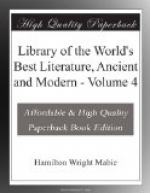Copyrighted by Fords, Howard and Hulbert.
LUDWIG VAN BEETHOVEN
(1770-1827)
BY E. IRENAEUS STEVENSON
We are warned on high authority that no man can serve two masters. The caution should obtain in aesthetics as well as in ethics. As a general rule, the painter must stick to his easel, the sculptor must carve, the musician must score or play or sing, the actor must act,—each with no more than the merest coquettings with sister arts. Otherwise his genius is apt to suffer from what are side-issues for temperament. To many minds a taste, and even a singular capacity, for an avocation has injured the work done in the real vocation.
[Illustration: BEETHOVEN]
Of course there are exceptions. The versatility has not always been fatal. We recall Leonardo, Angelo, Rossetti, and Blake among painters; in the ranks of musicians we note Hoffmann, Berlioz, Schumann, Wagner, Boito. In other art-paths, such personal pages as those of Cellini, and the critical writings of Story, of to-day, may add their evidence. The essentially autobiographic in such a connection must be accepted with reserve. So must be taken much admirable writing as to the art in which the critic or teacher has labored. Didactics are not necessarily literature. Perhaps the best basis of determining the right to literary recognition of men and women who have written and printed more or less without actually professing letters, will be the interest of the matter they have left to the kind of reader who does not care a pin about their real life-work, or about their self-expression as it really comes down to us.
In painting, the dual capacity—for the brush and for letters—has more shining examples than in music. But with Beethoven, Schumann, Boito, and Wagner, comes a striking succession of men who, as to autobiography or criticism or verse, present a high quality of interest to the general reader. In the instance of Beethoven the critical or essayistic side is limited. It is by his letters and diary that we study (only less vividly than in his music) a character of profound depth and imposing nobility; a nature of exquisite sensitiveness. In them we follow, if fragmentarily, the battle of personality against environment, the secrets of strong but high passion, the artist temperament,—endowed with a dignity and a moral majesty seldom equaled in an art indeed called divine, but with children who frequently remind us that Pan absorbed in playing his syrinx has a goat’s hoof.




